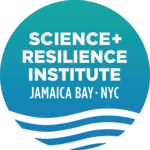From the Director
 Moving to New York City in the winter is underrated. It can be tough at first. Imagine a harsh environment with snow drifts blowing back a city that bustles in spite of itself. You get acquainted with the hard urban edges on the icy and treacherous commute. But, as things begin to thaw, the City becomes the epitome of spring – life. Life in all forms – human, natural, industrial – bound together by water on all sides. It is inspiring and reminds me that, while surging waters are a defining impact of our times, water is also a critical measure of the City’s vitality, health, and well-being. Tucked between Brooklyn, Queens, and the Rockaway Peninsula, Jamaica Bay is one of those aquatic vital signs – itself an indicator of resilience.
Moving to New York City in the winter is underrated. It can be tough at first. Imagine a harsh environment with snow drifts blowing back a city that bustles in spite of itself. You get acquainted with the hard urban edges on the icy and treacherous commute. But, as things begin to thaw, the City becomes the epitome of spring – life. Life in all forms – human, natural, industrial – bound together by water on all sides. It is inspiring and reminds me that, while surging waters are a defining impact of our times, water is also a critical measure of the City’s vitality, health, and well-being. Tucked between Brooklyn, Queens, and the Rockaway Peninsula, Jamaica Bay is one of those aquatic vital signs – itself an indicator of resilience.
I am incredibly grateful to be a part of a new chapter in the City’s history as the first, permanent Director of the Science and Resilience Institute at Jamaica Bay. The Institute is a catalyst for transforming Jamaica Bay, and the surrounding waters of the harbor estuary, into a symbol as iconic as the New York City skyline. The quality and health of Jamaica Bay and its ecosystem are a reflection of our past. The challenge of our future generations is grasping the opportunities Jamaica Bay presents for re-writing the urban experience.
The Institute is a rare partnership between science and society. A growing body of research shows that science designed in concert with decision makers and the public can be used to improve resilience. As part of the Institute, the region’s leading research institutions have committed to working with the City of New York, the National Park Service, and the many other communities and organizations that reside in and around these waters. We aim to develop a shared understanding of the Bay’s natural cycles and of the key events that have shaped human and natural communities in the Bay, all through the lens of resilience.
With support from the Rockefeller Foundation, Institute social scientists have been engaging communities in diverse settings around the Bay to understand how they perceive impacts and consequences from Hurricane Sandy, as well as what information might help inform decisions about how to make their communities more resilient. At the same time, we have been working with public agencies with jurisdiction in the Bay to use the latest science for weighing alternative management strategies to increase resilience.
With support from the National Park Service, we are collecting data and developing observation networks to help us assess and analyze past, present, and future conditions in the Bay. We are developing these tools and methods in ways that invite participation from communities. Students of all ages can help collect data on the Bay’s vital signs, and individuals and communities can use Visionmaker (see article in the Fall 2015 Newsletter), combined with innovative planning processes, to help the agencies expand healthy management solutions.
To reach diverse audiences around the City, knowledge developed through these projects will be available in a variety of formats. We are finalizing a book on Prospects for Resilience in Jamaica Bay for Island Press. Findings from our engagement with the communities will be published as part of an Institute report series, and we are using the web to make data and information available to everyone. Finally, because our relationships in the region are not just virtual, we are actively seeking applications for a three-year position as a Coastal Resilience Specialist, who will be on the ground in communities in and around the Bay.
The Extension Specialist will help ensure that communication is not just outward, but back into the Institute’s foundations. We will use feedback from various engagement efforts to build a strategic plan of the Institute, which will lay out a framework for linking knowledge to positive outcomes. Clean water, healthy waterways, and vibrant coastal communities are just examples of what will motivate the research of the Institute. In this regard, we are also excited to work with Dr. Susanne Moser and Dr. Elizabeth McNie, nationally recognized experts, to add an evaluation process to our emerging science framework, a process for learning what the Institute contributes to healthy and vitality over time.
The Institute is embarking on a new mode of discovery by building a collective context: over time, in place, and in collaboration with different views. Much has been said about the concept of resilience and whether it inspires the inquiry and action to meet the challenges of population growth, climate change, and development. We believe resilience is helpful. It invites knowledge gained through experiment, but also knowledge gained through experience. When we examine resilience, we examine how the course of our environment varies and changes in response to our actions and to forces well outside our control. We need our experience to refine that history and to determine what quality of life we hope to maintain or achieve. And, we need science to avoid recurrent mistakes. Put these sources of knowledge together, and we have a framework for learning how to preserve the quality of the Bay and, by extension, quality of life in the City.
-Adam Parris, Executive Director






